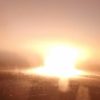In a corner of the southern Afghan desert, scorched by heat and thrashed by sandstorms, Nimruz is one of Afghanistan’s most remote and lawless provinces. Enjoying little international aid or government authority, it is also one of the least developed.
However, there is hope for progress. But that hope is pinned on a resource that could spark regional conflict: water.
The Afghan government plans to construct a dam to boost agriculture and livelihoods in a region where one of the main paths to profit is smuggling – of drugs as well as people.
One of Afghanistan’s many untapped resources, water has real potential. Of its 8m hectares of fertile land, Afghanistan cultivates only 2m. It imports 80% of its electricity. The dam, called Kamal Khan, could irrigate 175,000 hectares of land, the size of Greater London, according to project manager Mohammad Nabi.
Death of Mullah Mansoor highlights Taliban’s links with Iran
Read more
However, the dam project risks angering neighbouring Iran, which already frets about how slowly the Afghan Helmand river trickles over to its side of the border. Nimruz officials accuse Iran of paying local Taliban groups to sabotage the project.
“When work on the dam begins, of course security will worsen,” Ali Ahmad, a young police officer guarding the site said when the Guardian visited. He was manning a rudimentary checkpoint overlooking the endless, arid desert enveloped in a haze of sand. “Iran won’t let us build the dam. But we are ready to fight,” he said.
Iran and the Taliban were once arch-enemies, and water was one battleground. When it was in power, the Taliban closed the sluices at Kajaki dam, in Helmand, choking off water to Iran from 1998 to 2001. Coinciding with drought, that had devastating environmental consequences. Wetlands dried up, leading to mass migration of people living there. In 2001, after the overthrow of the Taliban, Iran asked the UN to get Afghanistan to release the water.
map
Since 2001, however, Iran and the Taliban have developed a pragmatic relationship. The governor of Nimruz, Mohammad Sami, pointed out that when a US drone killed the Taliban leader Mullah Akhtar Mansour in May on a Pakistani highway, he was returning from a visit to Iran. Sami avoided going into further details, but said that Iranian support for the Taliban was obvious. “Like sunshine,” he said.
Ties between Iran and the Taliban are well documented but have mostly been clandestine. However, in December Iran issued an unprecedented public invitation to the Taliban for an Islamic conference in Tehran.
In a briefing to Congress in December, the top US commander in Afghanistan, John W Nicholson, accused Iran of propping up the Taliban.
In 2011, a captured Taliban commander claimed to have received $50,000 and military training in Iran to sabotage the Kamal Khan dam. Officials elsewhere in Afghanistan have made similar accusations, pinning the assassination in 2010 of a police chief in Herat, home to the another large dam, on Iran.
The Helmand river rises in the Hindu Kush mountains close to Kabul and flows 700 miles south before pouring into the Hamoun wetlands on the Iranian-Afghan border. On the way, it passes Chahar Burjak and Kamal Khan dam.
Getting here is not easy, and requires a two-hour drive from the provincial capital, Zaranj, through punishing terrain without signs or roads, often through sandstorms.
Unsurprisingly, Nimruz is a haven for migrant and drug smugglers who travel concealed by the wind that whisks sand up from the ground like smoke, making sky and earth almost indistinguishable.
The dam does not look like much yet. The two first phases involved merely building a wall and reinforcing a dyke. Phase three – installing three turbines and a power station, and digging hundreds of miles of canals – has not yet begun. At an estimated cost of about $100m, the dam is slated for completion in four years.
The whole area looks abandoned, apart from 300 policemen. Some have been here for years. It’s a sizable force, admits the commander, Maj Fazal Ahmad Zori, but necessary. The Taliban are flush with Iranian weapons and cash, and can easily cross the border to restock and recuperate, he said.
The rising costs of water: dire consequences for Afghans in battle with Iranians
Read more
Last year, about 60 Taliban fighters on pickup trucks attacked a police checkpoint, said Hekmatullah, the commander of that checkpoint. His men got off lucky with few injuries, but he expects that when work on the dam picks up, so will the fighting.
Water has been a source of contention for many decades but the dispute has intensified in recent years, in which Afghanistan has directed portions of its international aid towards development projects.
In fact, the two neighbours have had an agreement to share the water since 1973, obligating Afghanistan to channel at least 22 cubic metres a second annually to Iran. Both countries have accused the other of breaching the treaty.
Most recently, in October 2015, Iran’s foreign minister, Mohammad Javad Zarif, when grilled by parliamentarians to demand more water from Afghanistan, said Afghanistan lived up to the treaty “inadequately and inconsistently”.
Meanwhile, a spokesman for the Afghan ministry of energy and water, Abdul Basir Azimi, assured that Afghanistan intends to enforce the treaty.
According to Andrew Scanlon, Afghanistan country manager for the United Nations Environment Programme (Unep), water no doubt holds genuine potential for sustainable development in Nimruz. “The key issue,” he said, is political negotiations.
For now, though, diplomacy is dormant. The Atlantic Council thinktank argues in a recent report that Kabul and Tehran prefer to rouse public opposition to the other side, rather than negotiate.
‘I am Lake Urmia’: a social media campaign takes on the environment in Iran
Read more
“Unfortunately, and largely for political reasons, both sides have failed to inform their publics properly and have fed them biased information despite the urgent need to improve water management and infrastructure,” the report says, calling on the US to mediate.
For his part, Nimruz governor Sami refuses to even speculate openly about what the perceived threat from Iran might entail.
“This is our right,” he said. “If we have water, the climate of this region will change. If Iran is not happy, it is up to them.”























































Свежие комментарии